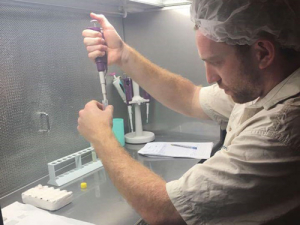The newly introduced process called vitrification uses ultra-rapid cooling of embryos produced by IVF to -196°C. This enables them to be stockpiled and transferred anywhere and at any time for use when convenient.
The process has now been developed to where it consistently achieves pregnancy rates of 50% or more.
Simon Walton, from the Australian Reproductive Technologies (ART) IVF, says this will be a “game changer” for dairy farmers and other producers.
“I’ve had some clients tell me it’s been the single biggest increase in IVF technology since its inception,” Walton says.
The process has been developed over the past eight years and stems from earlier human IVF work.
“The pregnancy rate in human IVFs from frozen embryos was awful, but they changed to a new method of freezing called vitrification, which uses ultra-rapid freezing, and it all changed,” Walton says.
The pregnancy rate of cattle from embryos using the traditional slow freeze method was just as bad, usually less than 25% success.
“I was fairly confident using the vitrification method was the right way to go about freezing the cattle embryos,” he says.
ART along with visiting Vietnamese researcher Do Van Huong have been trying to perfect the system for eight years.
“We started to see good results after 12-18 months but wanted to get more data behind us before we could announce things are working really well,” Walton says.
“We’ve now transferred hundreds of embryos for consistent 50% pregnancy rates and better.”
Walton says the ability to rapidly freeze embryos is a phenomenal change.
“Previously only being able to transfer fresh embryos meant we had to produce excess embryos to fill up numbers. We’d throw away 30% of embryos, which is huge waste of resources and genetics.
“It means that unlike flushing embryos, IVF allows a much better utilisation of genetics in that there are no hormones used to synchronise.”
Walton says that meant embryos can be produced from heifers before they reach puberty, resulting in a genetic gain.
“Rather than wait for an animal to hit 18 months before we can start to breed from it, we can start producing embryos at 10 months.
“We could just about have progeny on the ground by the time that heifer is ready to join.”
The new system will allow dairy farmers to produce embryos during the non-breeding season, freeze them, store them and transfer them en masse during the breeding season to match milk demands.
ART has secured a contract in Vietnam to produce 10,000 embryos. The process would be used to improve the genetics of the existing Vietnamese dairy herd.
It would also be used to expand the genetics of live beef cattle imports from Australia to Vietnam.
Walton predicts this method of freezing embryos will replace the traditional method. “It’s been taken up quite strongly already.”
















